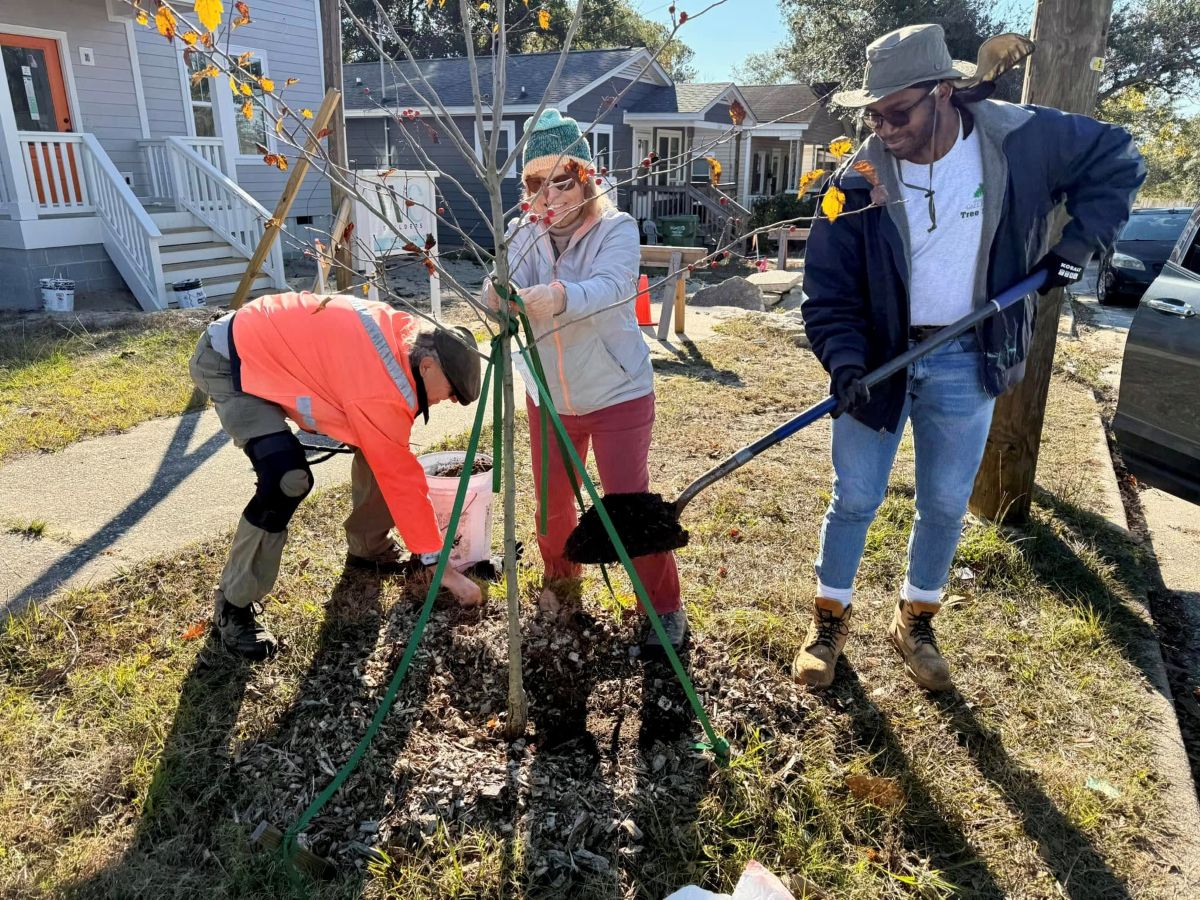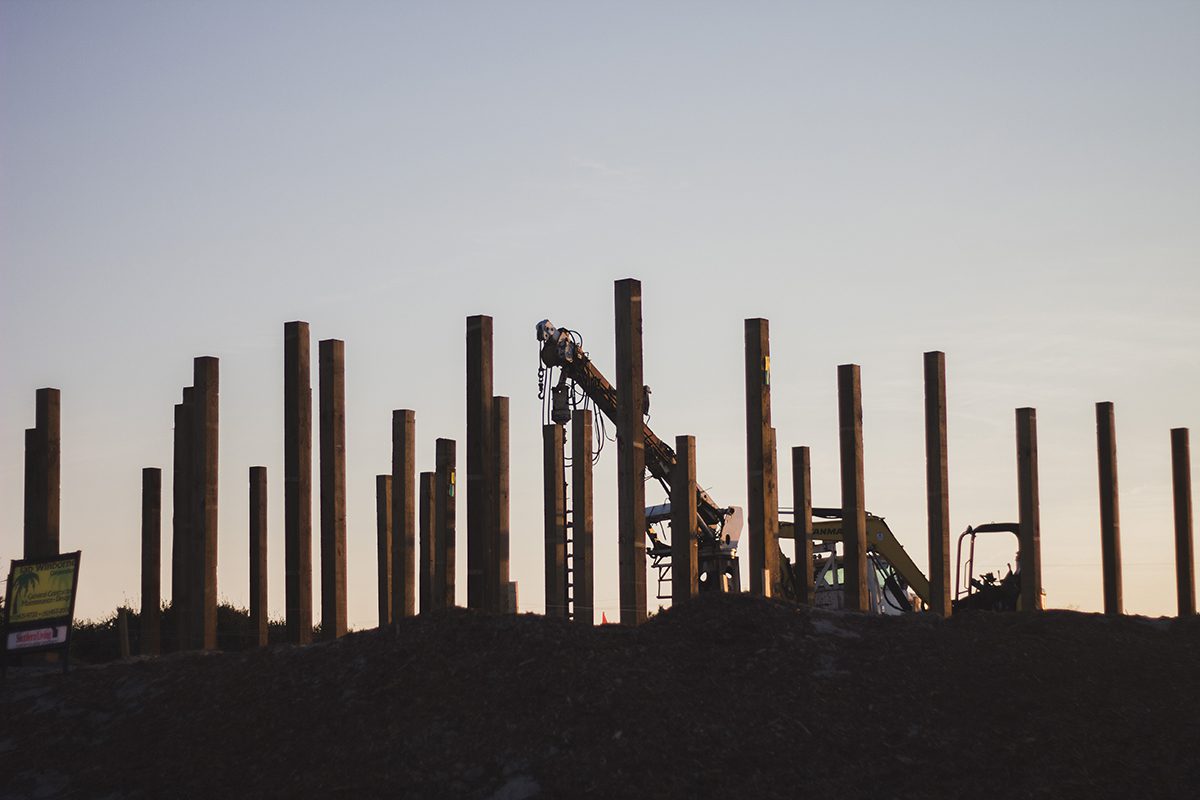
Second of two-part special series. Read part 1.
In Currituck County, on the northern Outer Banks, the maritime forests grow thick with southern live oaks. These trees can live up to 300 years, their twisted trunks spiraling out of sandy soil all the way down the Carolina coast. For centuries, they have borne witness to changing communities and landscapes.
Supporter Spotlight
On this 11-mile stretch, also known as “Carova” or “the 4×4,” which goes from the North Carolina-Virginia line to the start of the paved road in Corolla, there is a diverse range of ecosystems. The Atlantic Ocean swells, and stiff winds pound the exposed homes on the eastern side of the barrier island. Moving west toward Currituck Sound, the forest grows thicker before transitioning into marshy wetlands alongside a set of man-made canals. At the northern gates to False Cape State Park in Virginia, the forest grows tall enough to make you forget there is a beach nearby.
It was Carova’s natural beauty and quiet serenity that struck both Edna Baden and Elizabeth White, Carova residents since 1994 and 2004, respectively, inspiring them to move permanently.
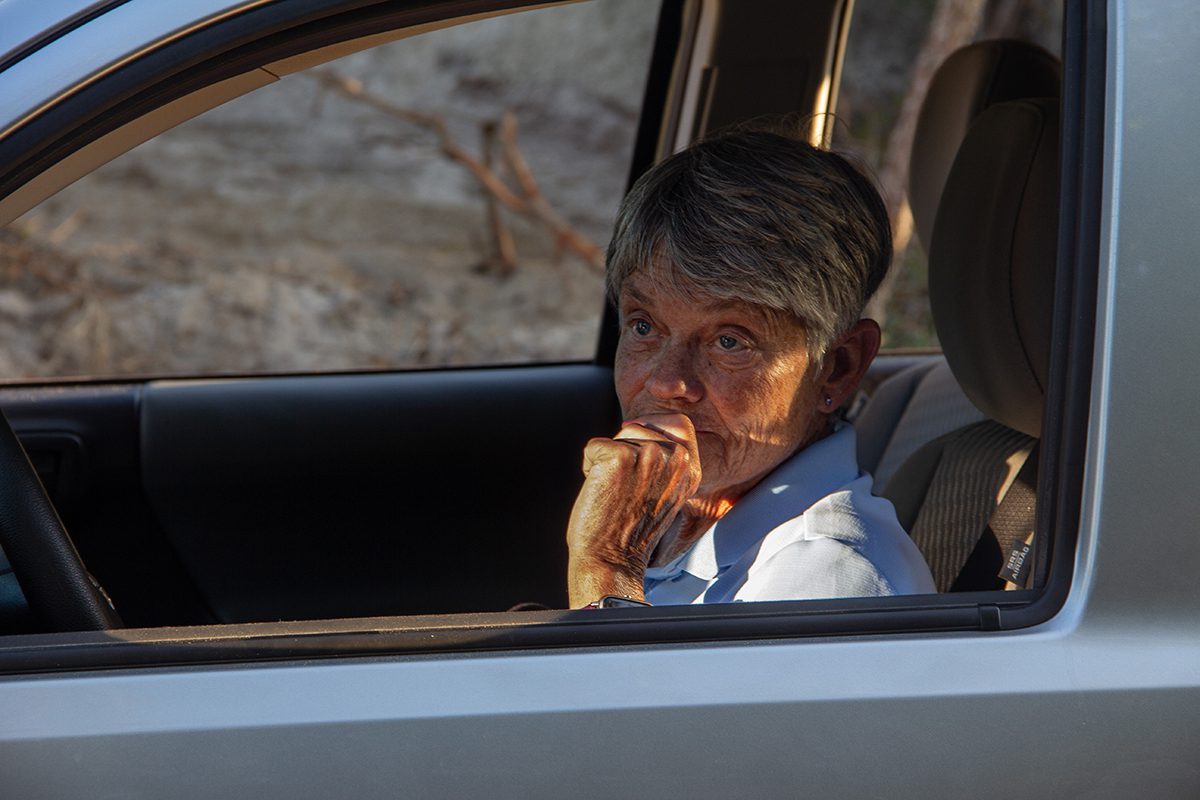
Maintaining protected, undisturbed areas also is important for the survival of a 500-year-old herd of wild Colonial Spanish mustangs that are a unique breed roaming 7,544 acres of beach, wetlands and forest that surround the 700 houses dotting the landscape.
Legend has it that today’s herd is composed of the descendants of horses left behind when Spanish settlers arrived on the North Carolina coast in the late 1500s. DNA testing by the Corolla Wild Horse Fund, a nonprofit founded in 1989 to protect the horses, supports this theory. Their research confirms that the Corolla wild horses are genetically isolated from other wild horse herds like their northern neighbors, the wild ponies of Chincoteague and Assateague islands.
The herd used to roam freely from the town of Duck up to the Virginia line. But when developers extended the paved road north to Corolla in the 1980s, the fund recorded more than 30 horse fatalities caused by the increased traffic on N.C. Highway 12. The organization decided in 1997 to create a sanctuary in the off-road area to protect the 20 remaining horses. The herd’s population today is roughly 100 horses.
Supporter Spotlight
Meg Puckett is a native Virginian who joined the Corolla Wild Horse Fund in 2016 as herd manager. She is on call 24/7 to respond to emergencies and monitor the animals’ behavior, migration habits, and general health and welfare. Because residents see the horses daily, and often know them well enough to identify them by name, Puckett frequently gets phone calls with news about a particular animal’s activity. In that way, the horses are also part of this community.
Yet, Puckett stressed that the horses are wild animals, different from domestic horses, so the fund tries to keep their intervention as minimal as possible. But she said that the changing environment threatens the horses to such an extent that the fund has had to intervene multiple times over the past few years to keep the animals alive.
“We had one mare that died from a disease called Potomac Horse Fever, which is caused by mayfly larva in the water. That’s something that normally would be killed off in a deep freeze, but we’re not getting deep freezes,” Puckett said. Another horse recently died on the beach after suffering heat stroke.
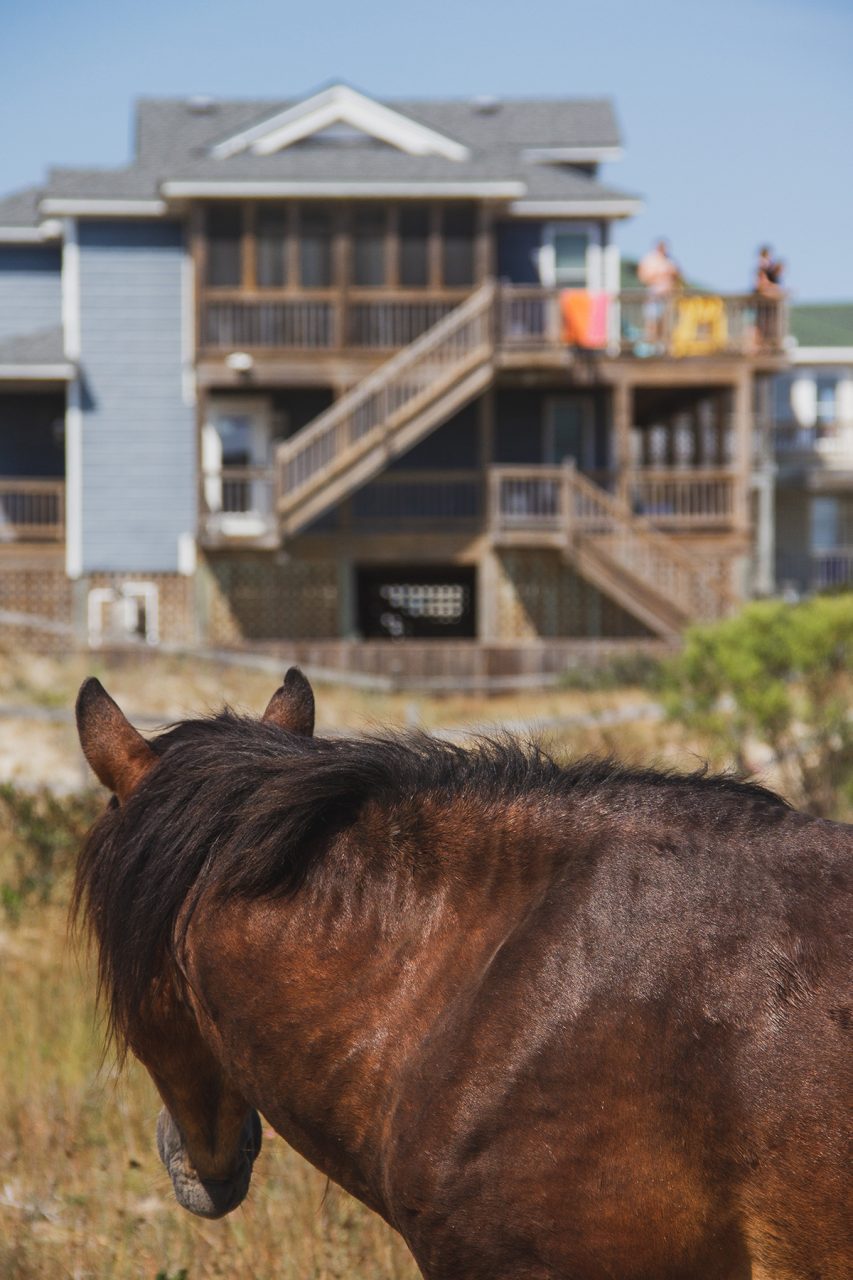
There have also been three confirmed cases and a fourth suspected case of equine pythiosis, commonly called swamp cancer, over the past two years, including one mare who had to be evacuated and now lives on the mainland. The Chincoteague herd also lost a few horses to the disease a few years ago. “That’s an infection that historically had really only been seen in more tropical climates,” Puckett said.
The infection is caused by fungal growth in decaying plant matter that is left in standing water. Irregular weather patterns driven by climate change bring intense rainfall and drought, creating patches of standing water, especially on beach roads where tire tracks have created indentations in the sand.
“We’ll get heavy flooding rain and then nothing. So you just have this stagnant water and then it never rains again to flush it out of there,” Puckett said.
Contaminated water is also an issue for people living on a shallow water table with no coordinated sewage-management system. Groundwater is only a few feet deep on most lots. Baden said everybody used to drink water straight from the tap, but no one does anymore.
Steve Grout, another longtime Carova resident, concurred. “Most people spend thousands of dollars on water filtration systems just to get stuff that comes out clear,” he said. “For most people, it comes out of their faucets brown.”
“All of this is tied into humans,” Puckett said. “When you start messing with the marsh … it’s supposed to flood, it’s supposed to filter that water. And when it can’t do that, that’s when you start to see problems.”
The Chowanog, Yeopin and Poteskyte Native Americans are the original inhabitants of Currituck County. Seasonal settlers like fishermen, lightkeepers, waterfowl hunters and the U.S. Coast Guard have passed through for centuries.
It wasn’t until the 1960s that commercial development was poised to begin in earnest in Carova as developers from Virginia Beach looked to expand. Vehicle traffic skyrocketed along the beaches, prompting the U.S. Department of the Interior to get involved and restrict vehicle access in 1973. Today, Carova remains free of high-rises and commercial development and is a prime destination for vacationers and second-home buyers.
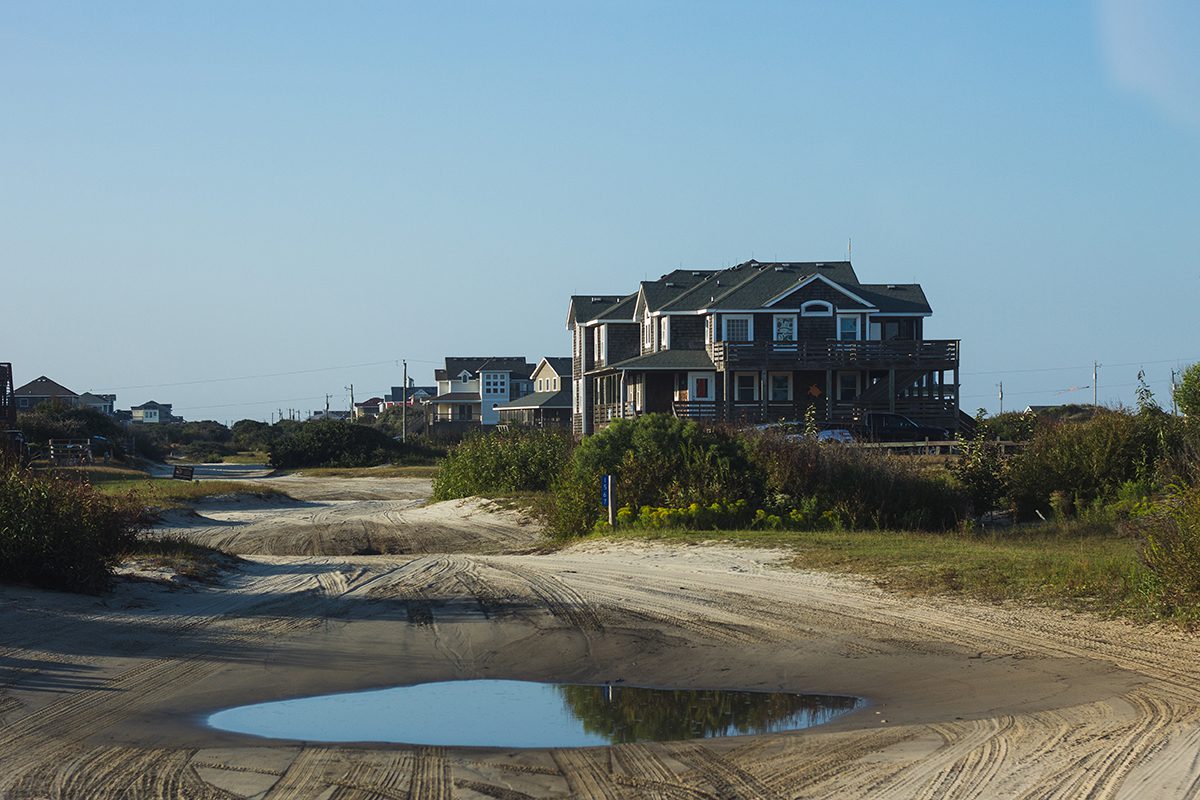
“Its attraction is that it is a relatively free area in terms of regulation,” said Clark Twiddy, president of Twiddy & Co., an Outer Banks property management company. “Swan Beach, North Swan and Carova have, I think, always held this place in our imagination as a free, natural environment with a minimum of human disturbance or human intrusion.”
But escaping to a seemingly wide-open space is inherently intrusive.
Along Carova’s sand roads, bulldozers idle over piles of fallen branches and dug-up sand. Horses graze between “for sale” and “no trespassing” signs on every corner.
The maritime forest grows behind the dunes, but the tree roots stretch under vacant lots awaiting clearing. Despite a designation under the Coastal Barrier Resources System, which strips federal funding to disincentivize development in storm-prone areas, single-family homes continue to spring up.
Many residents turn to work in the construction, real estate or tourism industries, which can contribute to the destruction of the environment they also aim to protect. And with the rise in lot sales over the past three years, more lots are always in need of clearing.
This gives Baden pause. “I bought my house when it was 10 years old,” she said. “For all I know, my lot could have had live oak trees.”
The lot next to Baden’s house was recently razed. Her neighbor, J-P Peron, a real estate agent and Carova resident, sold it to someone who may well become another neighbor. She watched as another neighbor cleared it. Baden refuses to walk on the lot — she feels bad energy. A lot of deaths happened there.
There’s also extensive construction in wetlands and other flood-vulnerable areas. Many of these places are on the Currituck Sound side and are likely to be underwater when sea levels rise a foot, which is almost certain to happen by 2050. More intense hurricanes, driven by climate change, on top of higher sea levels are also expected to cause more frequent floods in the coming decades.
Already in Swan Beach, which lies on lowland marsh, residents deal with flooding on a regular basis. To build in this area, property owners must bring in truckloads of sand to fill in low spots and create space for septic tanks and water systems.
“I’m astonished that they’re building where there are wetlands,” White said. “I never thought the area in front of my house would be developed because it’s clearly all wetlands, and the water needs to go somewhere.”
There are few regulations for building in Currituck County, in general, and the lack of federal support does little to hamper construction for those who can afford it. Also at issue is that the northern Outer Banks are in a roughly yearlong drought, according to White and her partner Bill Sanderlin. A common hangout area for the horses in Swan is usually waist-high with water but is completely dry these days. White and Sanderlin pointed out that many of Swan Beach’s roads are flooded 50% of the year, perhaps tricking recent buyers into thinking the land is drier than it is.
This is not enough for real estate companies to turn buyers away, however. “If you’re in the real estate business, you disclose things. And the only sin is a failure to disclose,” Twiddy said.
Once people are settled as full-time residents, it’s both common practice and a common pipe dream to try and prevent others from moving there too, whether it is to preserve the privacy of their space or, like Baden and White, to prevent more deforestation and conserve more space for the horses.
“The best buyers for vacant lots are the houses next door to them. If you’ve got the means and the opportunity arises, you jump on it,” Peron said. “I bought a lot to the south of me. I have not been able to buy a lot to the north of me. I’ve been trying for over a decade.”
“You picked that lot because it was so nice and open,” he continued, “but the last thing you want is to have a big, honkin’ house 20 feet away from you.”
The horses play into this land-grab effort, too. Residents are working to buy land and take it out of development so that the horses have enough room to roam and space to take shelter in case of extreme weather.
“The idea is to raise enough money so that we can buy all the land in a corridor that would connect from Swan Beach up to the Virginia line,” White said, who is helping with this project.
Twice, Peron has been able to get sellers to donate their lots to the Corolla Wild Horse Fund, especially in areas that are difficult to build on. Puckett is all for this practice: “I think that any lot that you take out of development is a good thing.”
Carova’s Climate Future
Climate threats are coming for Carova, and soon. What remains murky is what residents in the 4×4 area and people across the state are going to do about it.
One state project working on the ground is the North Carolina Resilient Coastal Communities Program, facilitated by the state Division of Coastal Management, which aims to provide communities with expertise and funding to complete resilience and adaptation projects. Currituck County representatives participate, but the county’s only listed project within the 4×4 area is a shoreline stabilization study to explore beach nourishment.
Farther south, on Pine Island sanctuary in Currituck Sound, Audubon North Carolina is beginning some marsh restoration pilot projects to strengthen eroding shorelines and elevate sinking wetlands through sediment application and creating structures with natural materials like Christmas trees.
The benefits that come from buying up neighboring lots can extend beyond the horses, helping improve ecosystem connectivity for other wildlife. “We are all here for a reason. The isolation, the environment. It behooves us all to protect it,” Puckett said. “If I’m protecting the horses, that means I’m also protecting the environment. If it’s healthy enough for the horses, it’s going to be healthy enough for all the rest of the animals.”
Yet, none of these projects will substantially help Carova residents prepare for higher seas, stronger storms, fiercer heat waves, or the other climate threats that are predicted to come their way.
Edward Ponton, who is one of the only full-time residents born and reared in the 4×4, wonders if these threats and other hardships are taken less seriously because people with multiple homes can escape. The Pontons are one of the families who have made Swan Beach their home for generations, and they don’t plan on leaving any time soon.
“You just wonder if some of those people are going to make their money and get out of here and we will be left with whatever is to come,” Ponton said. “My dad always likes to say piracy is alive and well on the Outer Banks.”
This is the second in a two-part special reporting series on climate change along the northern Outer Banks. Read part one here. This series is part of the Pulitzer Center’s nationwide Connected Coastlines reporting initiative.






